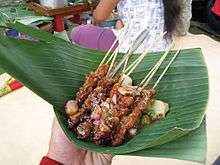Tapari
Tapari (Nepali: टपरी) is a leaf plate used in Nepal in traditional feasts, marriages and religious rituals to serve food or as a container to offer food and other items to the gods. Tapari is nowadays also used in urban fast food stalls in cities like Kathmandu.[1][2]
Tapari is made from mature green leaves of Shorea robusta (sal tree). Leaves are gathered and stitched together with fine bamboo sticks called sinkaa. Traditionally, women in the house build Tapari. It requires practice and skill to build Tapari.
There are three types of leaf plates/utensils. Tapari is the biggest of all, is curved and made of green Sal tree leaves. Duna is a bowl designed to hold liquids much easily. Bota is a tiny bowl made of only one sal leaf.
Steps to build Tapari
References
- "Tapari". Micro-Enterprise Development Programme (MEDEP). Retrieved 18 January 2014.
- Rysdyk, Evelyn C. (2019-02-19). The Nepalese Shamanic Path: Practices for Negotiating the Spirit World. Simon and Schuster. ISBN 978-1-62055-795-2.
- Tapari made with fresh Sal leaves
 Duna (smaller, more curved Tapari)
Duna (smaller, more curved Tapari)- A more modern version of the Tapari that was built using a die and hence its cleaner lines and shapre.
| Wikimedia Commons has media related to Tapari. |
This article is issued from Wikipedia. The text is licensed under Creative Commons - Attribution - Sharealike. Additional terms may apply for the media files.
